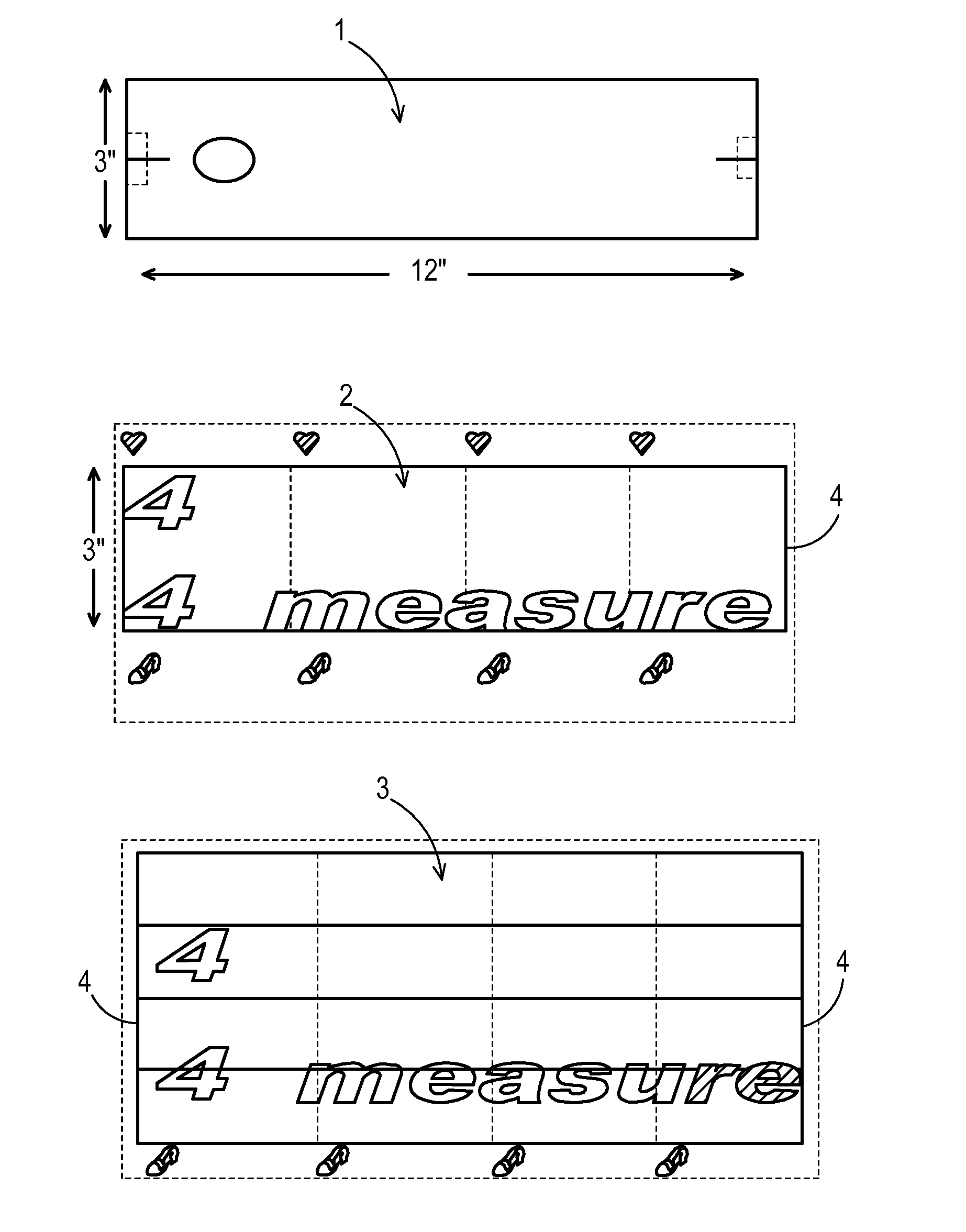[0006]In various exemplary embodiments, the technology described herein provides for music notation using manipulative Note Tiles that are transparent, magnetized, and mathematically proportionate to each other and to the relative lengths of sound durations represented by the notes inscribed on the tiles. Moreover the said Note Tiles adhere magnetically to a plurality of staved and unstaved Measure Plaques that are also in complete congruence with the lengths of the Note Tiles. The Measure Plaques, in turn, magnetically adhere to metallic
whiteboard Platforms which allow several Measure Plaques to be transported intact and attached to a wall or other surfaces.
[0025]An object of the technology described herein is to provide a notation system to teach music notation and composition, thereby increasing music student's success and ability to understand and easily compose music, particularly since young children are now required by U.S. and state standards, to read, notate, compose and arrange music using conventional symbols and Italian terminology.
[0026]Another object of the technology described herein is to provide a system of thick, transparent Note Tiles that look similar to glass tiles with music symbols painted onto them. The user of this system will select any given Note Tile and can slide it up, down or sidewise over a given Measure Plaque until the inscribed note overlays a staff line or space on the Measure Plaque. From a distance then, a painted note on any transparent Note Tile looks roughly like a note painted directly onto a staff, in much the same way a car window decal can be laid over a window graphic, giving the appearance of one complex picture rather than two simpler pictures. This ability to see through the Note Tiles so that they can be precisely positioned as an
overlay on top of the lines and spaces of the Melodic Measure Plaques is an important feature of this system, since music composition requires precision in the rendering of notes on lines and spaces. Another object is to provide a notational teaching system that can remain intact for composition and teaching purposes. The key elements of this system adhere magnetically to each other, creating an easy-to-use, durable system of that both children and adults may use that does not easily fall apart. The Measure Plaques in this system, for example, are comprised of magnetic
whiteboard and the backs of the Note Tiles also have magnets. Together this system enables the users to sit on the floor, at a table, or stand next to the wall-mounted Platforms and magnetically
affix their Note Tiles on one or more Measure Plaques. When users have assembled their composition, they are able to easily lift and transport their completed Measures Plaques and Platforms to their destination without worrying that their compositions might slide to the ground and ruining their efforts. Similarly, music teachers often need to demonstrate music theory and composition to classes in various rooms or parts of the classroom. A system that allows them to quickly assemble and / or remove a vast plurality of notes and symbols, and that enables them to safely transport notes, motifs or compositions, is a system that almost any music teacher would treasure.
[0027]Another object is to provide a notation system that is completely tactile as well as visual, a feature that is particularly important when children are learning concepts. “A significant research base has proven that while using manipulatives, student attention is increased and the children are highly engaged in the instruction being delivered. Retention is enhanced due to the game-like nature of the activities.” (Heritage Music Press) The engraved lines on the flanking sides of every Note Tile and Measure Plaque facilitate the accurate placement of music notes onto staff lines and spaces. The length of each Note Tile is also exactly proportionate to the length of that note's sound duration. Ordinarily, young students have a very difficult time calculating the relative values of notes, especially dotted notes. In this system, however, because it uses proportionate manipulatives, a person of almost any age can build one or more measures of rhythms in a matter of minutes.
[0028]Another object is to provide a notation system that is self-instructive. The student, when building a musical measure using said Note Tiles, can immediately see and feel if their selected notes fill a measure's allocated space, i.e., the area between the two adjacent bar lines which define a measure. Moreover, each type of Measure Plaque has easy-to-read inscriptions on it, denoting its
time signature and the correct number of beats for that measure, further informing the user about the measure he or she is using.
 Login to View More
Login to View More  Login to View More
Login to View More 


